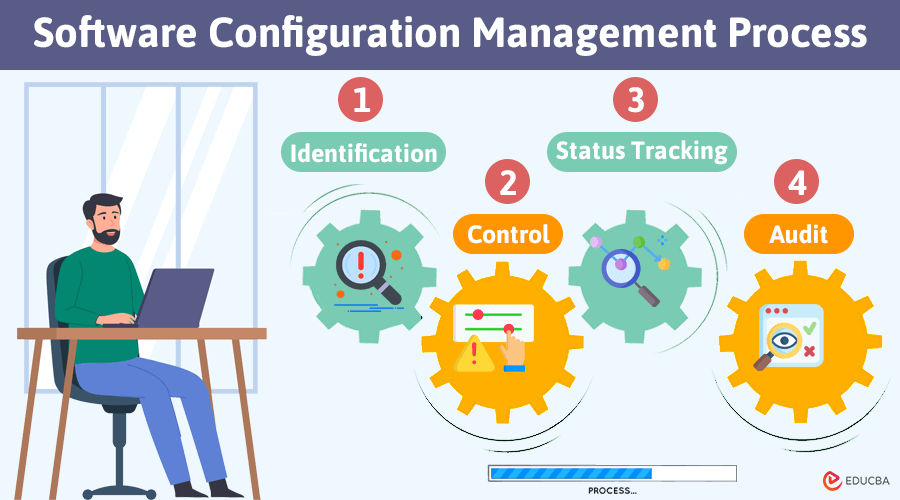
What is Software Configuration Management?
When an organization carries out Software Configuration Management (SCM), it means that it is overseeing and controlling changes within its software system. It involves:
- Identifying configuration items (CIs) like software code, hardware, and documentation.
- Controlling changes to these items.
- Tracking their status and versions.
- Conducting regular audits.
Table of Contents
Why Do We Need Software Configuration Management?
SCM is important for several reasons:
- Track and Manage Changes: SCM helps you track and manage changes easily throughout the software development process.
- Enhance Productivity: SCM helps increase the productivity and efficiency of software applications as it minimizes errors.
- Ensure Smooth Workflow: It streamlines the development process, ensuring a seamless workflow.
- Facilitate Team Communication: As SCM improves communication among team members, it leads to higher-quality products.
- Monitor Team Progress: This tool allows you to track each team member’s progress and status within the project workflow.
- Parallel Code Updates: SCM synchronizes code updates across team members, even when they use different version control systems.
- Manage Tools and Processes: It effectively manages various tools and development processes used in software projects.
- Control Software and Hardware: SCM manages the application’s software and hardware configurations.
- Manage defects and Teamwork: This helps control and manage defects and coordinate teamwork and processes.
- Manage Budgeting: SCM assists in managing the software budget according to changes in the application.
Software Configuration Management Process
The software configuration management process can be broken down into four key steps:
Step 1: Identification
The first step in software configuration management is identifying and labeling all configuration items. This includes the software code, hardware components, documentation, and other relevant items.
Step 2: Control
Once you identify configuration items, the next step is to control their changes. This involves careful monitoring, approval, and documentation of any modifications. Controlling changes ensures that all alterations are deliberate, authorized, and aligned with overall system objectives.
Step 3: Status Tracking
Continuously monitoring and documenting the current statuses and versions of configuration items is essential for maintaining a comprehensive system overview. Status tracking quickly identifies disc repancies or unauthorized changes, facilitating prompt corrective action.
Step 4: Audit
Regular auditing is a critical aspect of software configuration management. It involves reviewing the effectiveness of the CM process, identifying potential areas for improvement, and ensuring compliance with established guidelines and standards. Audits help maintain the integrity of the system and its components over time.
Benefits of SCM
Software configuration management offers numerous advantages:
1. Centralized Knowledge Base: SCM creates a centralized repository for all system and service configurations. This enhances maintenance and visibility, providing a single source of truth.
2. Simplified Onboarding: A well-defined SCM process speeds up the onboarding of new engineers by giving them a thorough understanding of the operational environment.
3. Efficient Testing: SCM ensures consistency between development, test, and production environments. This alignment reduces errors and increases deployment reliability.
4. Scalability and Reliability: SCM facilitates the easy provisioning of new resources, ensuring that systems are scalable. It also supports quick asset recovery in case of issues.
5. Enhanced Development Efficiency: SCM controls and tracks the workflow and improves the productive efficiency of software development processes.
6. Effective Change Management: SCM integrates with change management processes, mitigating risks associated with product changes and ensuring smoother transitions.
7. Improved Monitoring and Auditing: SCM supports thorough monitoring and auditing of the software development lifecycle, enhancing oversight and accountability.
8. Organized and Cost-Effective Development: SCM’s structured approach leads to organized, cost-effective, low-risk software development, resulting in a high-quality product.
SCM Tools
Various software configuration management tools assist with SCM:
1. Version Control Systems
Version control systems are crucial for tracking, managing, and documenting changes to source code. They record all modifications and enable multiple developers to collaborate effectively on the same project.
Examples: Git & SVN (Subversion)
2. Configuration Management Databases (CMDBs)
CMDBs manage configuration items, their dependencies, and relationships in a structured manner. They offer a comprehensive view of a system’s configuration, essential for controlling and understanding complex environments.
Examples: ServiceNow CMDB & BMC Helix CMDB
3. Automated Deployment Tools
These tools automate the deployment process and configuration across various environments, reducing manual effort and minimizing errors. Automation tools are critical for speeding up deployment cycles and maintaining consistency.
Examples: Jenkins, Ansible & Puppet and Chef
4. Configuration Management Platforms
Configuration management platforms offer visibility into configuration tasks and facilitate agile workflows by allowing teams to prioritize and manage their work effectively. These platforms are invaluable for maintaining efficiency and adapting to changing requirements.
Examples: Terraform & SaltStack
Challenges and Future Trends
SCM faces some challenges, including:
- Security Concerns: Ensuring all configurations are secure and protected against potential threats.
- Compliance Issues: Meeting regulatory and industry standards consistently.
- Adaptation to New Technologies: Keeping pace with rapid technological advancements and evolving practices.
Future trends in SCM include:
- Integration of DevOps Practices: Streamlining development and operations to enhance collaboration and efficiency.
- Broader Adoption of Infrastructure as Code (IaC): Automating infrastructure management to improve scalability and consistency.
- Containerization Technologies: Utilizing containers to increase flexibility and streamline deployment processes.
Final Thoughts
Software Configuration Management is vital for maintaining control over complex systems. By implementing SCM best practices and using the right tools, organizations can ensure their systems are reliable, scalable, and secure, supporting successful software development and operations.
Recommended Articles
We hope this guide to Software Configuration Management helps you understand its essential role in managing software systems. Check out these additional articles for more insights on optimizing software development processes and effectively leveraging SCM tools.
